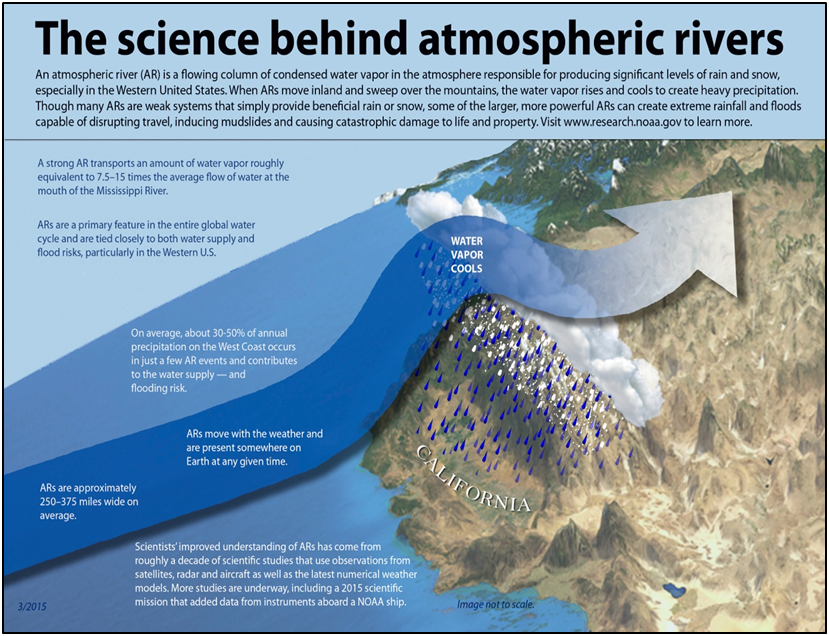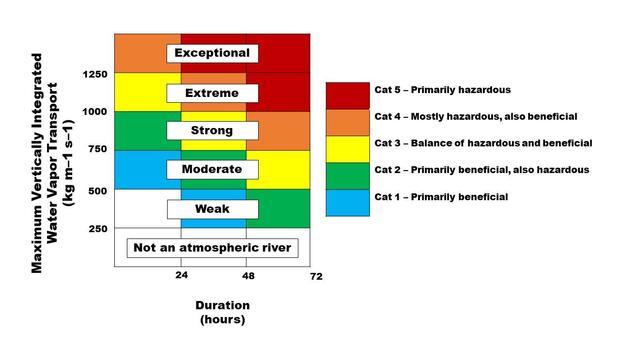Geography
Atmospheric River
- 12 Feb 2024
- 9 min read
For Prelims: Atmospheric River, Pineapple Express, National Oceanic and Atmospheric Administration (NOAA).
For Mains: Atmospheric River, Geographical features and their location, Impacts of Climate Change.
Why in News?
California, US is currently grappling with an extraordinary weather phenomenon known as an Atmospheric River also called Pineapple Express Storm, which has the potential to unleash up to 8 trillion gallons of rain over the state.
What is an Atmospheric River?
- About:
- The atmospheric river is a long, narrow band of moisture-filled air that transports significant amounts of water vapor from the tropics to higher latitudes.
- The Atmospheric River is often associated with mT (Maritime Tropical) air mass.
- When these rivers make landfall, they release this moisture as intense precipitation, which can manifest as either rain or snow depending on the altitude and temperature.
- According to the National Oceanic and Atmospheric Administration (NOAA), the water vapor they carry is roughly equivalent to the average flow of water at the mouth of the Mississippi River.
- So, when they make landfall and release all that water, they can cause extreme flooding.
- The atmospheric river is a long, narrow band of moisture-filled air that transports significant amounts of water vapor from the tropics to higher latitudes.
- Pineapple Express:
- The "Pineapple Express" is a well-known example of atmospheric river storms that bring heavy rainfall to the US West Coast, particularly California.
- This name originates from the fact that these storms draw moisture from the tropical waters near the Hawaiian Islands, resembling a "express" train of moisture originating from the vicinity of Hawaii, which is often associated with pineapples.
- This atmospheric river is driven by a strong southern branch of the polar jet stream and transports humid, warm mT air from as far away as the Hawaiian Islands .
Satellite image of clouds over the Pacific Ocean illustrating the “Pineapple Express,” a phenomenon in which a strong jet stream carries mT air from as far away as Hawaii to the West Coast.
- Categories:
- Category 1 (Weak): A Category 1 atmospheric river would be a milder and briefer weather event with primarily beneficial effects, like 24 hours of modest rainfall.
- Category 2 (Moderate): A Category 2 atmospheric river is a moderate storm with mostly beneficial effects, but also somewhat hazardous.
- Category 3 (Strong): A Category 3 atmospheric river is more powerful and longer lasting, with a balance of beneficial and hazardous impacts. For example, a storm in this category could bring 5-10 inches of rain over 36 hours, enough to help replenish reservoirs but also pushing some rivers close to flood stage.
- Category 4 (Extreme): A Category 4 atmospheric river is mostly hazardous, though also with some beneficial aspects. A storm of this rating could dump enough heavy rain over several days to bring many rivers to flood stage.
- Category 5 (Exceptional): A Category 5 atmospheric river is primarily hazardous.
- An atmospheric river that lasted over 100 hours over the Central California coast during the 1996-97 New Year's holiday period. The heavy rain and runoff caused over USD 100 billion in damage.
- Significance:
- They play a crucial role in replenishing water supplies, particularly in regions like the western United States. The heavy precipitation they bring can contribute significantly to reservoir levels, helping to alleviate drought conditions and ensuring water availability for agricultural, industrial, and domestic use.
- Given their importance for water supply, understanding atmospheric rivers is essential for effective water resource management and planning. This includes strategies for water storage, flood control, and allocation of water resources to meet various demands.
- Atmospheric rivers contribute to maintaining a balance in the hydrological cycle by transporting large amounts of water vapor from the tropics to higher latitudes. This helps to redistribute moisture across different regions, supporting ecosystems and agricultural productivity.
Note
An atmospheric river should not be confused with a traditional river found on the Earth's surface. Unlike a visible water body, an atmospheric river is an invisible, elongated corridor in the sky that carries large amounts of water vapor, influencing weather patterns and precipitation.
How Common are Atmospheric Rivers, and Where do They Occur?
- They're not limited to the US West Coast; they can occur worldwide. These rivers of moisture can stretch thousands of miles and affect regions like the UK, Ireland, Norway, and China.
- Atmospheric rivers often make the rainy season in China, known as Mei-Yu season, even worse.
- While they only account for 17% of storms on the US West Coast, atmospheric rivers contribute significantly to California's precipitation, snowpack, and major floods. They're predictable and can be forecasted up to a week in advance.
What is Air Mass?
- About:
- An air mass is a large body of air with relatively uniform temperature, humidity, and pressure characteristics. These masses of air form over source regions, where they take on the characteristics of the surface below due to low wind speeds.
- When air masses move, they can influence weather patterns in the regions they move into, potentially leading to the formation of storms when they interact with other air masses.
- Types of Air Masses:
- Continental Tropical (cT): These air masses originate over hot and dry continental regions. They are characterized by high temperatures and low humidity.
- Continental Polar (cP): Originating over cold and dry continental regions, cP air masses are characterized by cold temperatures and low humidity.
- Maritime Tropical (mT): These air masses form over warm and moist oceanic regions. They are characterized by warm temperatures and high humidity.
- Maritime Polar (mP): Originating over cold oceanic regions, mP air masses are characterized by cool temperatures and high humidity.
- Continental Arctic (cA): cA air masses originate over extremely cold Arctic regions. They are characterized by frigid temperatures and very low humidity.
- Characteristics of Air Masses:
- Air masses originate over vast flat surfaces having uniform temperature and humidity.
- Air masses travel slowly over hundreds of kilometers from their source regions.
- As the air masses move away from source regions their chief characteristics of temperature and humidity undergo large-scale changes.
- They affect the weather conditions of the areas visited by them.
- When two air masses of different temperature and humidity approach each other, they do not intermingle but a front is formed between them.
- Weather conditions change abruptly at the front.
- The front keeps two approaching air masses separate from each other.
UPSC Civil Services Examination, Previous Year Question (PYQ)
Prelims:
Q. The formation of ozone hole in the Antarctic region has been a cause of concern. What could be the reason for the formation of this hole? (2011)
(a) Presence of prominent tropospheric turbulence; and inflow of chlorofluorocarbons
(b) Presence of prominent polar front and stratospheric clouds; and inflow of chlorofluorocarbons
(c) Absence of polar front and stratospheric clouds; and inflow of methane and chlorofluorocarbons
(d) Increased temperature at polar region due to global warming
Ans: (b)
Mains:
Q.1 How do the melting of the Arctic ice and glaciers of the Antarctic differently affect the weather patterns and human activities on the Earth? Explain. (2021)
Q.2 Why is India taking keen interest in resources of Arctic region? (2018)
Q.3 How does the cryosphere affect global climate? (2017)









-min.jpg)